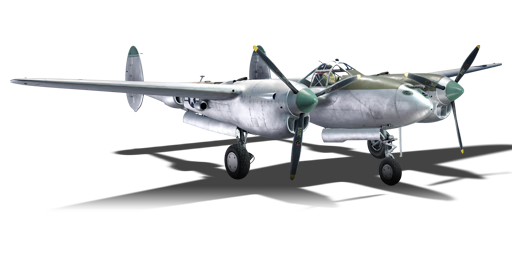



Throughout the many P-38 Lightning variants, one thing rarely changed, the engine nacelles. With the P-38J, also known as Model 422, the engine nacelles and cooling system was revised. Much of the cooling system was improved, such as a different intercooler and other airframe changes that greatly improved the ability to control the turbochargers. Although the P-38J had the same engine (V-1719-89/91) as the earlier P-38H, the better cooling allowed the P-38J to run at a higher power setting at high altitudes. The power increased by about 13%. The specific J-15 block had a better electrical system but was virtually the same as the earlier P-38J blocks.
Introduced in Update 1.53 "Firestorm", the P-38J-15 is a decent twin-engine fighter. The P-38J with its relatively good climb rate and air spawn, can easily climb above many fighters at its battle rating. Players should climb at about 275 km/h (173 mph) IAS for the best climb performance. The P-38J also has the same armament as many of the other Lightnings with four 12.7 mm machine guns and one 20 mm cannon all mounted in the nose. Although the P-38J has a structural limit of 790 km/h (493 mph), players should be cautious of going too fast as the high-speed compression issue wasn't solved at the time. This can make it hard to get guns on target or worse, slam into the ground. In addition, the P-38J can take bombs and rockets, but players should stick to attacking enemy aircraft. Overall, the P-38J is quite a good aircraft with some quirks.
flaps
flaps
flaps
brake
| Belt | Belt filling | Armor penetration (mm) at a distance: | |||||
|---|---|---|---|---|---|---|---|
| 10 m | 100 m | 500 m | 1000 m | 1500 m | 2000 m | ||
| HEF-I/AP-T | 39 | 36 | 25 | 16 | 10 | 6 | |
| AP-T/AP-T/HEF-I/HEF-I | 39 | 36 | 25 | 16 | 10 | 6 | |
| HEF-I/HEF-I/HEF-I/AP-T | 39 | 36 | 25 | 16 | 10 | 6 | |
| AP-T/AP-T/AP-T/HEF-I | 39 | 36 | 25 | 16 | 10 | 6 | |
| HEF-I | 5 | 4 | 3 | 2 | 2 | 2 | |
| Belt | Belt filling | Armor penetration (mm) at a distance: | |||||
|---|---|---|---|---|---|---|---|
| 10 m | 100 m | 500 m | 1000 m | 1500 m | 2000 m | ||
| API-T/AP/AP/I | 30 | 27 | 20 | 13 | 9 | 6 | |
| AP-I/AP-I/API-T/I/I | 28 | 26 | 18 | 11 | 7 | 4 | |
| API-T/I/AP/AP/AP-I/AP-I | 30 | 27 | 20 | 13 | 9 | 6 | |
| API-T | 28 | 26 | 18 | 11 | 7 | 4 | |
| AP-I/I/AP-I/I | 28 | 26 | 18 | 11 | 7 | 4 | |












Flight performance | |
|---|---|
Survivability |
|---|
Weaponry | |
|---|---|